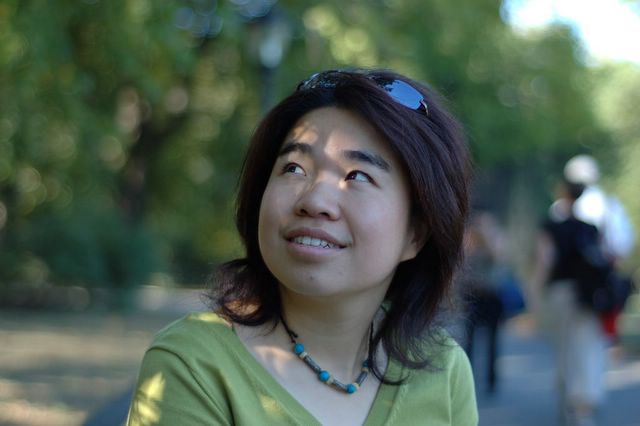I went to Guggenheim Museum with Mum yesterday. By chance, we met the new exhibition of Zaha Hadid, a pioneering architect originally from Iraq. You can see this is artistic and political gesture of the Museum. Always a favoriate of Guggenheim, Hadid is an internationally aclaimed artist for innovative ideas and achievement. She was famous far earlier than any of her design became reality. Her three dimensional drawings and design was created ahead of our current computer age. In 70s and 80s and 90s, she created a lot of symbolic works in Europe and Asia and America. There is someting about her very unique--the idea always comes before meaning.
From the exhibition:
"“My ambition is always to realize theoretical projects that seem difficult at the time.” —Zaha Hadid
Having first achieved international recognition through her striking images and designs, architect Zaha Hadid is widely known as one of today’s most innovative architects, consistently testing the boundaries of architecture, urbanism, and design. Born in Baghdad in 1950, Zaha Hadid studied in Switzerland, England, and Beirut. She pursued architectural studies at London’s Architectural Association in 1972 and received her diploma in 1977. Shortly after, she joined the Office of Metropolitan Architecture (OMA) with her previous professors, Rem Koolhaas and Elia Zenghelis. She opened her independent practice in London in 1979. In 1982 she garnered international recognition when her submission The Peak won the competition for a leisure club in Hong Kong. The project was never completed, but since then, several audacious buildings have given material form to her search for challenging ideas. In 2004, Zaha Hadid was the first woman to receive architecture’s most prestigious award, the Pritzker Architecture Prize.......Hadid is an architect who consistently pushes the boundaries of architecture and urban design. Her work experiments with new spatial concepts intensifying existing urban landscapes in the pursuit of a visionary aesthetic that encompasses all fields of design, ranging from urban scale to products, interiors, and furniture. Best known for her seminal built works (Vitra Fire Station, LFOne/Landesgartenschau, Bergisel Ski Jump, Lois and Richard Rosenthal Center for Contemporary Art, BMW Plant Central Building, Hotel Puerta America [interior], Ordrupgaard Museum Extension, and Phaeno Science Center, her central concerns involve a simultaneous engagement in practice, teaching, and research."
哈蒂德的作品好像是卡通空间中的幻想曲。早在电脑动画盛行之前,她的想象力已经帮助她在平面上绘制出三维立体的建筑设计。比如一处水边的娱乐中心,她将一个人从360度的视角所看到的景色,从头到尾绘制在一个长轴上,使你领略到在空中飞行的感觉。从这个意义上说,她的建筑绘画类似于《清明上河图》,是流动的空间和时间的组合。有的时候,觉得她过于注重流动的感觉,使得这个建筑看起来不伦不类,好像电影里未来世界的样子。但是她的巧妙之处就在于,她的建筑(雕塑)作品总能在峰回路转之际,把你带回到另一个空间中。比如她设计的宝马汽车的总部,整个建筑的外观就像是外星人的飞船。但是一旦进入内部,这个空间分而不隔,融会贯通。装配生产线上的汽车从人们头顶的流水线上穿过,人们就在下面的餐厅里用餐。一切都井然有序,但是别出机杼,给人不同凡响的感觉。不久之前纽约的现代艺术美术馆(MOMA)有一个特别展览,介绍西班牙的现代建筑,其中就包括哈蒂德的作品。这个展览给人的感觉是西班牙好像是现代建筑的实验室,各种新奇而怪异的设计都能够从中间生长出来。相比之下,美国美术馆的建筑就显得比较古板。除了洛杉矶的盖蒂中心(Gatty Center)和迪斯尼中心(Walter Disney Center),以及纽约的古根海姆美术馆,多数的美术馆循规蹈矩。甚至是芝加哥的当代美术馆和三番的亚洲美术馆,在外观的设计上也没什么新意。倒是边陲小镇圣胡安(San Juan, Puerto Rico)的美术馆和现代艺术中心,颇有些惊世骇俗的想法。
我这个人旅行,不论到哪里都喜欢看两样东西,这个城市的美术馆和它的公立图书馆,它们基本上能够代表这个城市的历史、趣味和品位。转了一圈儿,我觉得我还是喜欢纽约。在去公立图书馆的路上,我喜欢低下头来,阅读镶嵌在人行道上的关于书和言论自由的至理名言。有一天我有了一个家,我就要把书页镶嵌到有机玻璃的夹层里,铺满我的墙壁。这样我就可以一边做一边阅读。不要电视,只有音乐和书籍。我要在这个感官文化泛滥的世界里给自己建立一个绿洲。现在开始体会到极少主义的意味了。少即是多。
又及,昨天看到古根海姆美术馆关于波洛克(Jackson Pollock)的特展:No Limits, Just Edges。 对于Pollock得好感,源于帮助老朱翻译关于美国抽象表现主义词条的时候。但是似懂非懂地机械地翻译着一本现代艺术的入门书,第一次认识了
Jackson Pollock,
Willem de Kooning,
Mark Rothko。后来看了Ed Harris 演的Pollock 的生平传记片,认识了他不安于寂寞的灵魂。对他的好感有一大半是来自于我们共同的对El Greco 作品的喜爱。2003年大都会美术馆将全世界格里科的作品借来,另外又在展厅之外,专门陈列了波洛克年轻的时候(1937-1939年)临摹格里科的习作。我一直觉得格里科是一个超越时代的艺术家,他将自己的灵魂放到他的宗教绘画当中。波洛克也是一样。从MOMA收藏的他的大幅作品中,人们似乎只会注意到他的信马由缰、不拘小节。但是从古根海姆这次展出的小幅作品中,可以看出他对于绘画所抱有的虔诚地宗教情结。我不知道他是否和克莱因一样通过日本接触到东方的水墨艺术,但是在很大程度上,他同样着迷于水和墨在不同材质的纸上所形成的不同效果。他后来所发展出来的“行动绘画”的风格,也许就来自于早期的点滴试验吧。
From the Exhibition:
"Today, Pollock’s iconic, large-scale canvases are recognized by museumgoers the world over. Yet his smaller, intimately scaled works on paper often come as a revelation to even the most seasoned art audiences. No Limits, Just Edges: Jackson Pollock Paintings on Paper—the first retrospective devoted exclusively to Pollock’s works on paper in 25 years and organized on the occasion of the 50th anniversary of his death—specifically considers Pollock’s draftsmanship as an essential component in his transformation of the traditional figurative line into nonfigurative allover abstraction."


没有评论:
发表评论